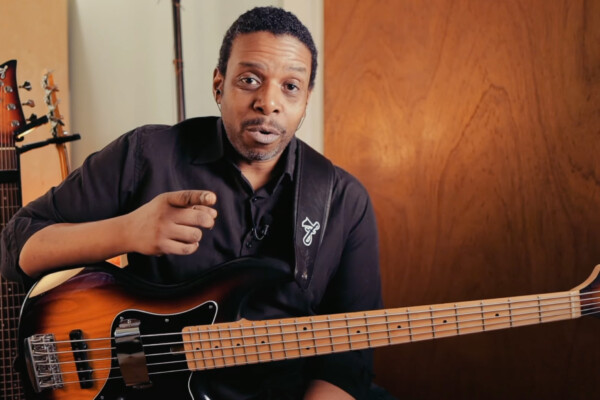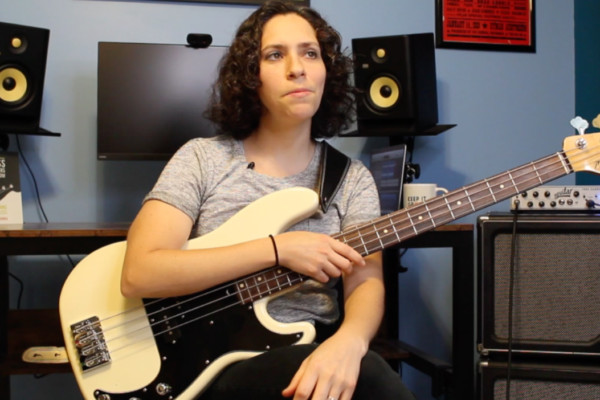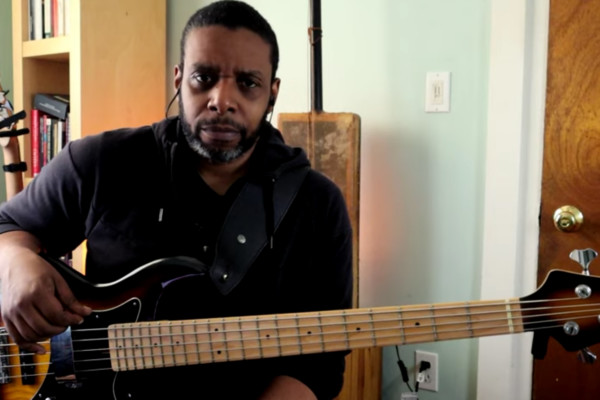How To Come Up With New Groove Ideas

Q: Do you have any tips for how to come up with new groove ideas?
A: I spent quite a few years doing what I call “fishing”. What I mean by that is, aimlessly using different notes and rhythms hoping to stumble upon something interesting (This is especially true with my soloing back in the day, but that’s another column).
I had a breakthrough in most every aspect of my playing when I really started to work on rhythm and technique. For this column, we’ll be focusing mostly on the rhythmic aspects of playing. My breakthrough came when I started to consider what the best way to work on rhythm would be. The answer, when it came to me, seemed obvious. Think like a drummer! This led to me experimenting with various rhythmic groupings, reading through snare drum rudiment books, and essentially, trying to ignore harmony and focus on rhythm exclusively (my next step was to introduce harmonic exercises using various rhythmic groupings). The idea that seemed to most directly relate to groove experimentation was that of displacement. Most great drummers I know will take a fill or groove and experiment with it by displacing it by various subdivisions – each shift changing the feel and flow of the base idea. They also experiment further by playing different drums, different stickings, swinging vs straight, etc… the possibilities are endless but lets just focus on displacement.
The concept is simple, but it can be trickier to put into practice in real time. Check out the included audio track and notation (below). For the purposes of demonstrating how one might use this idea to come up with new content, I took on fairly simple groove idea and then displaced the entire line by a 16th note, 8th note, dotted eighth and quarter note. The hardest part for me was really hearing the new groove and not my original idea. It takes a little bit of concentration to try and hear the line as if it always existed in it’s displaced form. Generally speaking, displacing an entire groove by any subdivision should drastically change the way the groove feels and, in turn, my require that you experiment with your phrasing in order to really sell the line.
I added a very simple MIDI drum groove and click to the example so you should all hear how it changes the approach of the line. Of course, in the real world, the drum groove would compliment the displaced groove, which will lead to an entirely new feel for the rhythm section as a whole (and thereby, the band as a whole).
Personally, I have a hard time simply thinking, “okay, now play everything an eighth note later” and actually being able to do it. For this reason, I tend to write out displacement ideas so I can see how the new groove lines up against the downbeats and bar lines.
As a matter of practice and experimentation, I would also play around with accenting different notes/rhythms of the displaced groove. We know that displacing the groove changes the way it feels, so experiment with trying to mentally sync up with any new groove idea (feeling it from the new side of the beat) and practice emphasizing different sections or beats within the groove to see how it changes the overall feel. What may have seemed like an emphasized note in the old groove may wind up being better played as a nuance in the new groove, emphasizing a different part of the phrase (it’s funny to write into words but you’ll know what I mean when something that fell on a harmonically strong beat (1 or 3) now falls in between beats, or on a harmonically weaker beat (2 and 4).
Note: In a bar of 4/4, beats 1 and 3 are considered harmonically stronger beats while 2 and 4 are weaker beats, meaning that beats 1 and 3 tend to define the harmony, while 2 and 4 are more transitional. The same holds true for 4 bar phrases in standard western music. (i.e.: beat 4 is really about leading your ear to beat 1 of the next bar, typically.)
When I work on these concepts with students I am usually met first by confusion and an inability to play or hear anything other than the original groove or line. However, it doesn’t take that long to get the idea in your head and, once you feel comfortable with the idea, it comes to the fingers and ears relatively quickly. Again, writing it down first helps to “see” it.
Be patient and take it slow, work with a drum machine or metronome so you have something to mark the time and downbeats. Keep working the groove or idea until you can actually “feel” it comfortably. Not every subdivision displacement will yield a hip or useable line but there always seems to be at least one or two that will sound cool to your ears and that will give you more ideas to play with in your own groove development.
Often, it is simple as realizing that staring with a rest can significantly improve the cool factor of a groove. Take note of what you like or don’t like about the ideas that you come up with. Take those new ideas and try and come up with an entirely new line using that new rhythm as it’s foundation.
For these examples, I only went as far as displacing it by one 16th note at a time over the course of one beat but you could conceivably come up with 16 variations on one line if you kept going, shifting the line as a whole, one 16th note at a time.
Don’t be afraid to experiment with different subdivision types as well! Take a 16th note line and try to play in as 8th note triplets. You can drop a few notes, or expand the length of your bar or phrase (16 8th note triplets would take you 4 triplets into bar 2, so you’ll need to decide how to deal with that and make the groove fit in some kind of cyclical way).
The possibilities are seemingly endless once you get going down this path and there is a LOT of fun to be had and a lot to learn in the process. Have fun, take it slow and get creative with it!
Download this Groove Displacement Examples chart and follow along with the track:
Have a question for Damian Erskine? Send it to [email protected]. Check out Damian’s instructional books, Right Hand Drive and The Improviser’s Path.




I’ve stumbled on this on my own, i practice this regularly